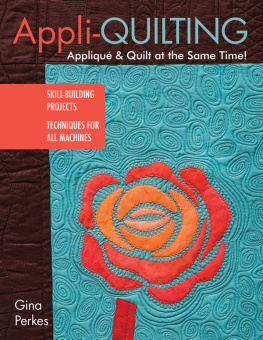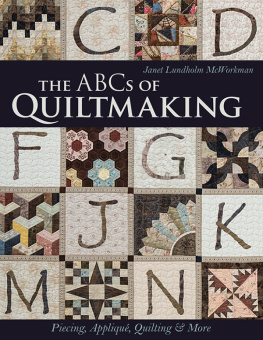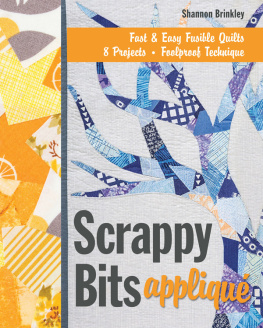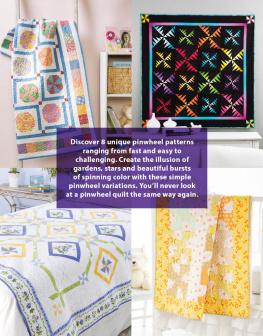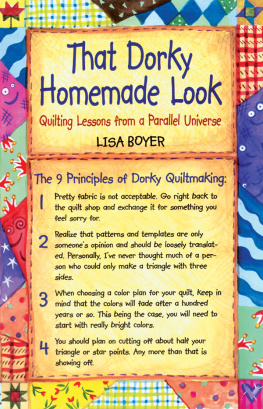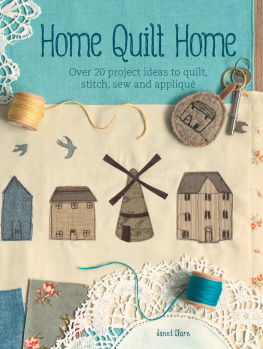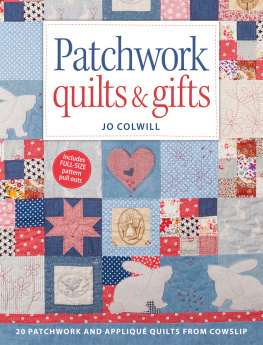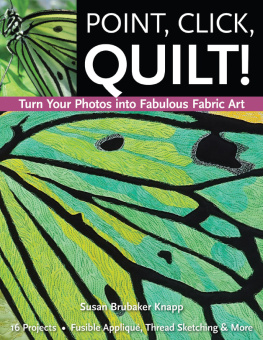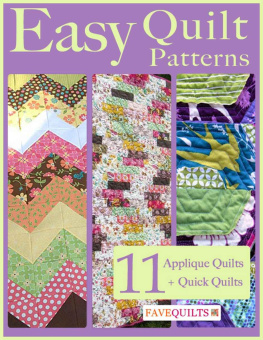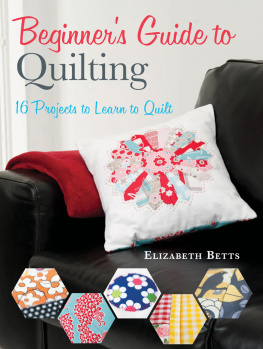Koolish Lynn - Appli-Quilting: applique & quilt at the same time!
Here you can read online Koolish Lynn - Appli-Quilting: applique & quilt at the same time! full text of the book (entire story) in english for free. Download pdf and epub, get meaning, cover and reviews about this ebook. City: Lafayette;CA, year: 2016, publisher: C&T Publishing, genre: Home and family. Description of the work, (preface) as well as reviews are available. Best literature library LitArk.com created for fans of good reading and offers a wide selection of genres:
Romance novel
Science fiction
Adventure
Detective
Science
History
Home and family
Prose
Art
Politics
Computer
Non-fiction
Religion
Business
Children
Humor
Choose a favorite category and find really read worthwhile books. Enjoy immersion in the world of imagination, feel the emotions of the characters or learn something new for yourself, make an fascinating discovery.
- Book:Appli-Quilting: applique & quilt at the same time!
- Author:
- Publisher:C&T Publishing
- Genre:
- Year:2016
- City:Lafayette;CA
- Rating:5 / 5
- Favourites:Add to favourites
- Your mark:
- 100
- 1
- 2
- 3
- 4
- 5
Appli-Quilting: applique & quilt at the same time!: summary, description and annotation
We offer to read an annotation, description, summary or preface (depends on what the author of the book "Appli-Quilting: applique & quilt at the same time!" wrote himself). If you haven't found the necessary information about the book — write in the comments, we will try to find it.
Appli-Quilting: applique & quilt at the same time! — read online for free the complete book (whole text) full work
Below is the text of the book, divided by pages. System saving the place of the last page read, allows you to conveniently read the book "Appli-Quilting: applique & quilt at the same time!" online for free, without having to search again every time where you left off. Put a bookmark, and you can go to the page where you finished reading at any time.
Font size:
Interval:
Bookmark:
Publisher: Amy Marson
Creative Director: Gailen Runge
Editors: Lynn Koolish and Katie Van Amburg
Technical Editors: Alison M. Schmidt and Deanna Csomo McCool
Cover/Book Designer: Page + Pixel
Production Coordinator: Zinnia Heinzmann
Production Editors: Jennifer Warren, Nicole Rolandelli, and Alice Mace Nakanishi
Illustrator: Kirstie L. Pettersen
Photo Assistant: Carly Jean Marin
Instructional photography by Diane Pedersen, unless otherwise noted
Published by C&T Publishing, Inc., P.O. Box 1456, Lafayette, CA 94549
Dedication
This book is dedicated to my beautiful daughter, Rylie. She adds color and sparkle to my world with her radiant energy. She is my only daughter, my first-born child, my best friend, and my inspiration!
Acknowledgments
Thank you to my students for your enthusiasm for the Appli-Quilting technique!
A big thank-you to C&T Publishing for working with me on this project and publishing amazing resources for quilters! Id like to especially thank Lynn Koolish, my developmental editor, who provided patience and guidance through new, uncharted territory (a book with projects).
Thank you to my support system: Kathy Hunt, Debbie Vaughn, Arleen Logan, and Felicia Brenoe. You are always willing to help at the eleventh hour, testing patterns, cutting, pressing, gluing down appliqu shapes, and speed binding. You are all amazing women whom I love and cherish!
Introduction
Early in my career, I was very fortunate to meet Linda V. Taylor, an amazing woman, quilter, and pioneer in the longarm quilting industry. She was incredibly encouraging to me, and I am so thankful for the confidence that she helped me to build.
I was quite new to the world of show quilting and hadnt even begun to teach when Linda invited me to be a guest on her show Lindas Longarm Quilting. I was completely honored and extremely scared. What could I possibly have to teach other longarm quilters? I thought, experimented, and played at my machine, trying to develop a novel concept using my longarm machine.
Blanket stitching and couching on a longarm were born! For more than a decade, I have developed the Appli-Quilting technique, and now I teach it throughout the country. I am pleased that it is every bit as fun and easy using a longarm as it is using a home sewing machine.
My favorite thing about this book is that it combines two popular and amazing techniquesappliquing and quiltingproviding extremely versatile and interpretive techniques with endless possibilities. I hope that you enjoy learning Appli-Quilting and creating pieces either from the book or from your imagination! I encourage you to apply your own creative twists to my technique, using your own unique versions of the stitches and designs. Allow yourself to become lost in your happy, quilty world. Remember, quilting is cheaper than therapy!
How to Use This Book
Machine Requirements
Appli-Quilting can be beautifully executed on any style of machine. The only machine requirements are that the feed dogs can be disengaged and the machine can perform a single stitch. I have used Appli-Quilting with both longarm and domestic machines, computerized and noncomputerized. Throughout this book, I have included tips for both longarm and domestic machine styles. Appli-Quilting is based not on what your machine is capable of but on what you can create with your own imagination and skills. Always remember: Its not the violin; its the violinist.
Longarm versus Domestic Sewing Machines
LONGARM
When I refer to a longarm machine, I am referring to a quilting machine that is attached to a track system. With this style of machine, the quilt is loaded onto the frame rather than sandwiched. The machines themselves are quite simple. Once the quilt is loaded, the quilter moves the machine over the quilt to create quilting designs. The quilt remains stationary. Longarm machines do not have feed dogs; the quilting is always free motion. These machines are only capable of straight stitching. The operator is the one who produces the designs by guiding the machine.
DOMESTIC
When I refer to a domestic, or home, machine, I am referring to a sit-down style of home sewing machine. Sit-down longarm (and mid-arm) machines are also becoming quite popular. This style of machine is stationary and is mounted to a cabinet or table. With these machines, the designs are created by moving the quilt sandwich beneath the stationary machine. The quilt layers should be sandwiched ahead of time.
For Appli-Quilting, you dont use the feed dogs or computerized/built-in stitches. The machine should be in its simplest form: feed dogs disengaged and a straight stitch selected with the stitch width set at zero. The stitch length doesnt matter; it will be determined by how fast or slowly you move the fabric. Though a stitch regulator may be used to keep the stitch length consistent, it is not required or necessary.
Choosing Your Methods and Fabrics
The Appli-Quilting technique can be used with any appliqu project, including those in this book (see Projects). After you have selected a project, decide on a method or combination of methods, as discussed in Preparing the Shapes. Select your fabrics based on the method or methods you plan to use; certain fabrics work best with certain methods. The patterns are all easily translatable based on your preferences and style. I encourage you to make the designs your own and have fun in the process!
Choosing Your Stitches
There are no limits on the stitch designs that can be created with Appli-Quilting. Stitches features a wide variety of both traditional and nontraditional stitch designs. You may wish to use a variety in one project or stick with just one or two. You have the creative license to choose whichever stitches you think fit your quilt.
Creating the Quilt Sandwich
After your appliqu designs have been prepared and tacked in place, prepare your quilt sandwich using your preferred basting or pinning method. If you are using a longarm machine, load the three layers onto the machine. At this point your appliqu shapes are not stitched down, only tacked temporarily. The shapes are stitched down with the quilting using Appli-Quilting.
Fabric Selection

Texture feeds your sense of touch.
Any fabric may be used for raw-edge appliqu, though nonraveling fabrics are my preferred choice because the stitches discussed in the following chapters are fairly open. Unlike dense satin stitching, which secures the fabrics edges within the stitches, open stitch designs leave the fabric edges somewhat exposed. These uncovered edges can begin to ravel or fray over time.
When used for raw-edge appliqu, the following fabrics add a special element to your designs: texture! Most quilters fall in love not only with the visual appeal of quiltmaking but with the process of working in a tactile medium. Introducing textured fabrics into your world feeds your sense of touch, adding to the joy of quilting.
Ultrasuede
Ultrasuede is a beautiful fabric with many unique characteristics. In the 1980s and early 1990s, Ultrasuede was popular in the fashion industry and was often used by garment sewers. These days its less commonly used in garments, though it has become quite popular in the home decor industry. I have been using Ultrasuede in my quilts for more than fifteen years. I love the sophisticated touch that it adds to my appliqu designs. Though it is a very expensive fabric ($30$60 per yard), small doses can have a large impact. I like to use it mainly for the appliqu shapes, combining it with less expensive background fabrics. The following are some of the qualities that make this fabric an appealing choice for raw-edge appliqu.
Next pageFont size:
Interval:
Bookmark:
Similar books «Appli-Quilting: applique & quilt at the same time!»
Look at similar books to Appli-Quilting: applique & quilt at the same time!. We have selected literature similar in name and meaning in the hope of providing readers with more options to find new, interesting, not yet read works.
Discussion, reviews of the book Appli-Quilting: applique & quilt at the same time! and just readers' own opinions. Leave your comments, write what you think about the work, its meaning or the main characters. Specify what exactly you liked and what you didn't like, and why you think so.

